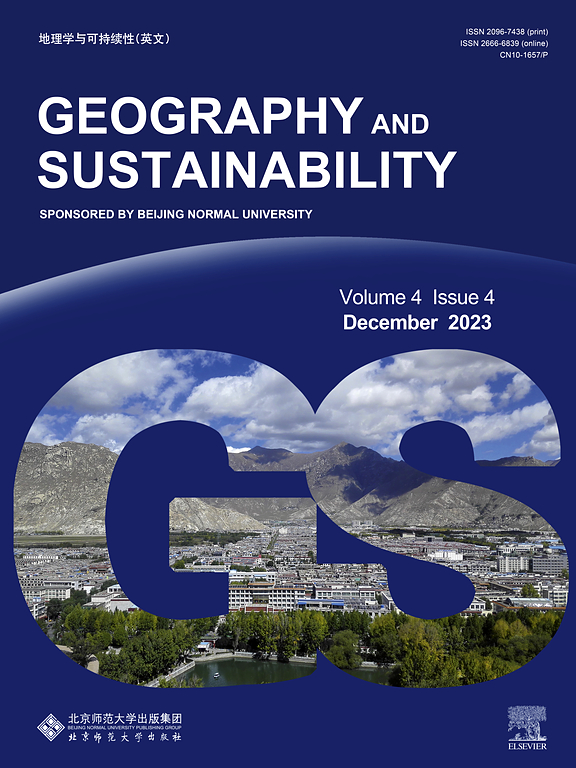Non-negligible large impact of potential forestation on livestock production in China
IF 8
1区 环境科学与生态学
Q1 GEOGRAPHY, PHYSICAL
引用次数: 0
Abstract
Forestation projects have been identified as an important component of climate mitigation strategy to reduce greenhouse gas emissions worldwide. However, most previous studies ignore the impacts of potential forestation projects on livestock production, which is crucial to the livelihoods of local people. In this study, we identified potential forestation areas in China by integrating random forest regression model and LPJ-GUESS model. The impacts of potential forestation on carbon storage and pasture-based livestock production were then analyzed. The results showed that China has a potential forestation area of 43.2 million hectares, accounting for about 19.6 % of the country’s forest area as reported in the 9th National Forest Inventory. If all these regions are reforested, China’s forest cover will increase to 27.4 %. Furthermore, 1.58 Pg C of new above- and below-ground carbon would be sequestered, about an increase of 17.2 % of current forest carbon storage. However, the potential forestation may result in a significant negative impact on existing pastures and the amount of livestock. It can reduce 4.7 % of beef, and 0.8 % of mutton products from China’s livestock sector each year. These significant declines will result in a huge gap in China’s livestock products supply, posing a serious threat to food security and the livelihoods of many people. Our findings highlight that potential forestation projects should further consider a reasonable pasture protection strategy to balance the potential carbon sequestration and the socio-economic benefits of livestock production.

中国潜在的造林对畜牧业生产的巨大影响不容忽视
造林项目已被确定为减少全球温室气体排放的气候缓解战略的一个重要组成部分。然而,大多数先前的研究忽略了潜在的造林项目对牲畜生产的影响,而牲畜生产对当地人民的生计至关重要。本研究采用随机森林回归模型和LPJ-GUESS模型相结合的方法,确定了中国的潜在造林面积。分析了潜在造林对碳储量和牧畜生产的影响。结果表明,中国的潜在造林面积为4320万公顷,约占第九次全国森林清查中报告的全国森林面积的19.6%。如果所有这些地区都重新造林,中国的森林覆盖率将增加到27.4%。此外,新增地上和地下碳的1.58 Pg C将被封存,约增加目前森林碳储量的17.2%。然而,潜在的造林可能会对现有的牧场和牲畜数量产生重大的负面影响。它每年可以减少中国畜牧业4.7%的牛肉和0.8%的羊肉产品。如此大幅度的下降将导致中国畜产品供应出现巨大缺口,对许多人的粮食安全和生计构成严重威胁。我们的研究结果表明,潜在的造林项目应进一步考虑合理的牧场保护策略,以平衡潜在的碳封存和畜牧业生产的社会经济效益。
本文章由计算机程序翻译,如有差异,请以英文原文为准。
求助全文
约1分钟内获得全文
求助全文
来源期刊

Geography and Sustainability
Social Sciences-Geography, Planning and Development
CiteScore
16.70
自引率
3.10%
发文量
32
审稿时长
41 days
期刊介绍:
Geography and Sustainability serves as a central hub for interdisciplinary research and education aimed at promoting sustainable development from an integrated geography perspective. By bridging natural and human sciences, the journal fosters broader analysis and innovative thinking on global and regional sustainability issues.
Geography and Sustainability welcomes original, high-quality research articles, review articles, short communications, technical comments, perspective articles and editorials on the following themes:
Geographical Processes: Interactions with and between water, soil, atmosphere and the biosphere and their spatio-temporal variations;
Human-Environmental Systems: Interactions between humans and the environment, resilience of socio-ecological systems and vulnerability;
Ecosystem Services and Human Wellbeing: Ecosystem structure, processes, services and their linkages with human wellbeing;
Sustainable Development: Theory, practice and critical challenges in sustainable development.
 求助内容:
求助内容: 应助结果提醒方式:
应助结果提醒方式:


